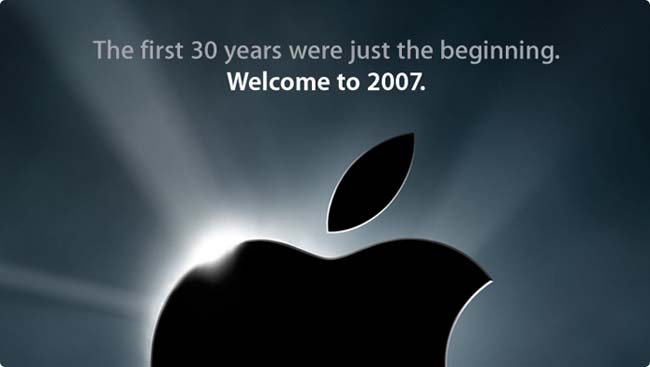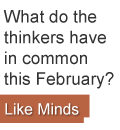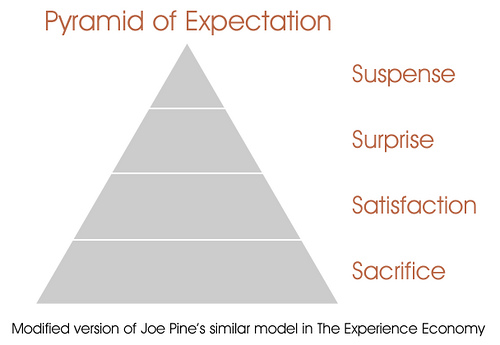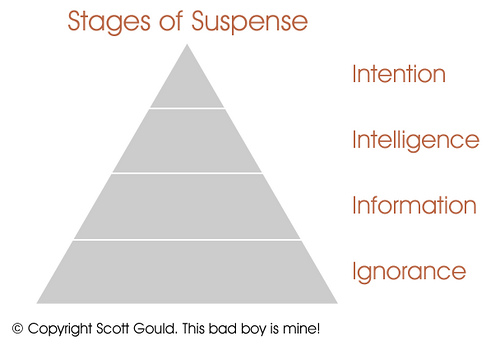
I spoke a while ago on the idea of what I’m calling ‘brand mystery’ – we looked at JJ Abrams’ TED Talk and Lost, and how he tells a story by suspense. He never provides the complete picture, and this is what keeps you hooked. This is contrary to what one copywriter thought when he said “every advertisiement should tell the complete story” – to which I wholeheartedly disagree. Discovering a brand, and unravelling its mysteries, is such a rich experience (and one that I’ve been enjoy since childhood) that it ties you emotionally into it for years to come.
I wrapped some of these ideas up under the word ‘Suspense‘, which I describe as the experience of anticipating an experience. Today, using Star Wars, Apple, Lost, Louis Vuitton, Like Minds, and general meandering between them and other examples, I’m going to hit you with three (long) pointers, and then open this up to discussion to expand our ideas. Let’s begin.
Episode 1. Anticipation is tied into expectation.
No greater example of dismally failed expectations exists in my life than when I saw Star Wars Episode II: Attack Of The Clones. For 3 years leading up to the film I had been building it up and up in my mind, imaging how the events of the next episode in the saga would unfold. For the months leading in I read everything about it that I could, re-watched the trailers ad nauseum, read every ‘theory’ on what would happen from other geeks fans as deduced from the trailers, and even made my own costume to wear to the premiere, complete with glueing a Jedi-inspired braid into my hair. Yeah, I know. Diehard.
Suffice to say that nothing could match my expectations. They were huge. As my suspense peaked at galactic heights just before the credits rolled, the ensuing 3 hours just slowly sucked away my love for Star Wars. From then on, I was bitter. They had lost a brand advocate.
Suspense begins with expectation. If I don’t expect anything, then I have nothing to anticipate. But if I expect something, then I anticipate it, and woe betide anyone who fails at delivering on expectations. So it is required then that my expectations are correctly managed, motivated or manipulated (depending on how you see it), in order to increase in my levels of anticipation, and therefore, my experience.
This provides lesson 101 of suspense (and indeed, much of marketing), which is, what expectations does your product/event/org/service set? When I look from afar at the product/event/org/service, what do I expect to get when I transact (purchase) it?
This expectation is very sensorial, even though we often find it hard to express our expectations. Certainly in my research, I’ve found when people’s expectation’s aren’t met, there is a mix of ‘feel’, ‘look’, ‘sound’, ‘taste’ that weren’t right. They are all built up in the mind by expectation.
So then, we enter the world of branding, and language, semantics, images, connotations, etc etc. The question to ask yourself is: what are you making people expect? I think this might be an even more important question to ask than “what are you making people feel?” Branding, marketing and advertising can make people feel things, but I’m more interested in getting their suspense built up than just playing with emotion.
I could give lots of examples here of how this works, but I don’t want to make this too long, so I’ll present one from this week. Yesterday I was drawing up an advert that we’ve been given space to put up for Like Minds in February, and rather than getting bogged down into the details of the event, given the small size of the advert, I created this:

Yeah. It’s little. It doesn’t say much. But you expect three things from it: 1. that this event is so well known it doesn’t need to say when it is, 2. that this event is so well attended that it doesn’t need to say when it is, and 3. that this is a statured event, because it doesn’t try to promote when or what it is. The result of those expectations? Hopefully, that you’ll click the link, and come, based on an impression of stature and a hint of mystery (more on that later.)
(Also, just to cover my back here, I’m not saying that those things are necessarily true about Like Minds and I’m not being all arrogant – we have a long way to go.)
So, getting back to the story – the original story, that is – how could this Star Wars disappointment have been circumvented? I’m not sure it could’ve – this is a very extreme case because I had been building up to it obsessively for years (I’ll tell you more why that matters in a moment.) But I think there is a lesson that can help others not make the same mistake that lies in what Apple does:
Episode 2. Expectation is best when the end is not known (and also why Customer Satisfaction is a load of rubbish.)
As we know, a few times a year when Apple is getting ready with a product launch, they leak a little bit of information which subsequently gets the rumour mill going. The rumour mill creates mockups, ideas and conspiracy theories all around this stuff, and stock begins to rise like an eagle as the world braces itself for the latest Apple innovation.
Yet no one knows what this latest innovation is. They’re all caught up in suspense. (Side note: yes, stockholders get caught up in suspense too.)
Haven’t you ever wondered how this happens so well? Well…
When the end isn’t known, you allow what Guy Kawasaki calls ‘letting 100 flowers blossom’. People’s minds just go to work letting 100 flowers blossom that have nothing to do with the actual thing they’re making. And this is a good thing – it’s your message spreading. This is what’s happening with Apple – people don’t know the end (the product) so they go off in 100 directions and create all new and wonderful ideas which in turn keep the buzz up and the shares rising.
The beauty of this is because no one knows what the thing is – what the end is, that is – they know they might be wrong. When they know they may be wrong in the first place, they are acknowledging that “if you disappointment me, I know that it was because I was expecting something that you didn’t promise.” So if Apple doesn’t do exactly what they had in their mind, they are emotionally prepared for it, and don’t feel disappointed because Apple broke a promise – the promise didn’t exist.
This idea of promise here is a big deal in my opinion. ‘Customer Satisfaction’ is talked about like it’s the great goal to achieve, but satisfaction is really just what happens when someone receives what they were promised. It means my expectation is met. If I get less than what you promised to give, then I’m not satisfied – I’ve had to sacrifice. You have not fulfilled my expectations. And if I get more than you promised, then you exceed my expectations and I am very satisfied – or rather I am surprised. But satisfaction, really, is no big woop. Seriously, in this day and age we should be beyond just delivering what we say we will.
You may be wondering where suspense fits in. So glad you asked. If you continue to surprise me, then what happens? I expect the next surprise – which is an experience of anticipating an experience. That’s suspense.
This model below explains the four levels. I’ve modified it from something similar that Joe Pine did in the Experience Economy (good read, and an affiliate link)

The diagram reflects that most people are in customer sacrifice, and most companies are delivering to that level. Then we make our way up to the heady heights of suspense. Just to note, some great advice on using this is available on my blog, on the subject of ‘Under-Promising, Over-Delivering.’
So, going back to Apple – that’s the secret of their product launch success and cult fandom? Well the better question is, what do they wonderfully avoid doing when they leak these bits of info about their new products? They avoid making promises. Bingo. That way, the fan’s expectations can’t be met, over met, or under met.
They essentially avoid dipping (for the most part) below satisfaction because they never made a promise to sacrifice on in the first place!
Well, they didn’t make a promise, except for one little thing:
Brand Promise.
This is the big promise that is in everything you do. Everything. So although Apple avoids making the smaller, more specific promises, it has to deliver on the big promise. It must check the big promise box, which for Apple, is innovation.
I told you earlier I’d say why Star Wars could never make this work. So, why didn’t Star Wars work? Because I knew the end. I knew that they had to fit certain storyline elements in – things that I had imagined how they’d happen for years – meaning they had to compete against the whole world that I had built in my mind. I experienced customer sacrifice. And there was no way that I could be wrong here, because it wasn’t like I knew that that I was wrong, as in the case of the Apple fan that dreams knowing they are only dreams. In this case, it was just a matter of how.
And we know that how you do something matters a lot to a lot of people. When people don’t know how, or are marvelled by how, you have magic. But when people scrutinise how, then you have criticism.
Think about it. When books become films, what do people say?
So we’ve now got two guiding principles. Let’s go through one way to make this work – at the end of which, I’ll tell you how Apple could do an even better job with their product launches.
Episode 3. The trick of mystery is all in what you don’t see
I began this peice by discussing brand mystery. I prefer this to the idea of brand story to be honest. A story is something you read, but discovering a mystery is a game you play. It’s far more involving. It’s far more participatory. It’s far more spreadable.
If you watch Lost or 24 (two of the most enrapturing programmes on television), every clue or peice of information is made out to be of vital importance. Of course in a few episodes time, that subplot won’t matter much any more, but for the time being, it is all you can see, and accordingly your mind fixates over it with the questions “what does this mean?” and “what happens next?”
It’s funny isn’t it. What you see has made you think about what you don’t see.
(Where else does that happen? Oh yeah, with Apple!)
Take, for instance, the recent release Daybreakers. After seeing that trailer I was hooked. Questions running through my mind like “how did they become vampires?” and “how does this humanised vampire society function?” and “what’s going to happen?” The trailer didn’t make me say, “I want to go to the movies to just see that same scene again“. It made me want to go the movies to go and find the answers to all these questions that I had.
It’s like lingerie – lingerie beautifully accentuates a woman’s body by glamourously covering her up. It’s about what you don’t see as well as what you do see!
In letting “100 flowers blossom”, and for your audience to begin anticipating, you need to consider what you aren’t showing them (and what they will want to see) by what you are showing them. Philosophical I know. You could also put it this way:
People want to see what they can’t see.
If we go back to my advert for Like Minds, what am I showing them? I’m asking them “what do the thinkers have in common this February?“, so on the surface, I’m telling them that there is something for ‘thinkers’ and that it is in February. From what I have shown then, what do they not see, that they want to see?
I’m guessing they want to see what the thinkers have in common. They want to see what who the thinkers are. They want to see why there’s such little information here.
So now they have a level of suspense. Really, it’s ignorance. They don’t know what they don’t know. They probably have wrong impressions about Like Minds. I remember thinking a whole bunch of things about Nike trainers that were wrong. It’s part of the game.
Say they visit the website – now they have information, and enter a new phase of suspense, in which they’ve acquired some information. This is important. If you allow someone to feed off of ignorance for too long, then they cement their false expectations. Of course, you don’t give them all the info they need: just enough to make their expectations more aligned to reality, and enable them to make their next discovery. It’s like planting a trail. Each part only leads onto the next.
After information, comes intelligence. This is when they can decipher the bigger picture – which is still exciting, and still full of suspense. One major reason why this phase is perhaps even the most exciting is because up until this point you might not have ever purchased the thing you are in suspense and playing the brand mystery game with. Let me provide a personal example with the help of Louis Vuitton.
The first time I heard the name, I assumed this guy Louis was alive. I knew he made hangbags, because someone said they dreamt that “Louis Vuitton had asked them to make handbags”, and I had to no reason to think that Louis was dead, or that he was actually a fashion house! (On another side note, I know my friends have whacky dreams. Mine are even whackier.) At this stage, I had ignorance.
Then after sometime I began to acquire information. Louis Vuitton made a bag that has his initials on, and in actual fact, he was around a hundred years ago, and so was no longer living, except through the fashion house in his name. At this point, though, I thought all they made were bags. The intelligence started coming when I started searching online and found fakes on ebay, found they did other types of bags, and even did bags for men. But it was when I first went into a Louis Vuitton store that intelligence completely set in and I understood that Louis Vuitton was more than bags. And as I said above, at this point, I had not bought anything from Louis Vuitton – yet I was enamoured over them. I had the bigger picture.
This was many years ago, and to this date, I have not bought a Louis Vuitton item. What stage am I in now? Intention. One day, I will purchase this item. I intend to do it. Of course I do – we have history!
The below model presents these stages in the same way to the Pyramid of Expectation:

Intention means I am poised to purchase when I am in a position to. And the waiting game makes this intention stronger in many cases – especially with luxury goods.
Epilogue: One More Thing
So what about Star Wars? Did Episode III regain my trust. No. But it wasn’t as bad. And subsequently I’ve been less and less disappointed with movies. You know why? Because I don’t expect much from them anymore.
And this is the danger when your audience experiences customer sacrifice, they stop expecting. They stop getting too excited.
There is a lesson here for Apple. It’s hidden in all this thinking, but hear me out:
When Apple announced the iPhone there was fanboy hysteria. There it was, in Steve Job’s hands in January 2007, and over the following 6 months I, along with many others I’m sure, browsed the pages of the iPhone website over and over, watching tutorials and seeing how it would work. When it came to seeing the phone for the first time, there was still hysteria. I was pumped to get my hands on it (I was in America for the launch), and when I laid my hands on the thing after this 6 month wait .. I surprisingly .. had little to do with it.
You see, Apple had done such a good job of pre-selling the iPhone, that when it came to holding it my hands, there was nothing new for me, because I’d done it all over the 6 months.
You know what would’ve been cool? If there had been one more thing. Steve’s awesome product lacked his defining line.
What if there had been something on the phone that they didn’t tell you about upfront? A surprise. What if when you held the phone, there was an app, or something that it did, that made you hold the thing for longer and really want to explore it because you hadn’t seen it online and read about it ad nauseum?
That would’ve created a whole new surge of Fanboy interest – the fact that there was something on the phone that you could only see if you went and held onto it – not just looked at it online. That would’ve been innovative. But it’s not too late, Steve, if you’re reading – you still can do it with other products!
I don’t know if you’ve noticed, but I pointed out brand examples I’d use at the beginning of this post, and a few times said I’d get to discussing a point in full later in the article – and took a while to get around to them. My expectation would be that you might’ve forgotten about those by now – but when you read them, they created just a little bit of suspense that helped you get through this post!
So let me hear from you. I’ve used these ideas for numerous events and campaigns, but I wonder if you’ve been using them too. I’m also curious about how you think this works with Social Media and a ‘connected lifestyle’. For instance, didn’t the article title create a little bit of I want to see what I can’t see in you?
Finally, there’s one more thing: there’s more in the post than there was in the title. That doesn’t seem to be the case with many blogs today, where there’s more in the title than there is in the preceding 400 words. One more thing – the hidden thing – is what you put in when you are more interested in connections that crowds.
At the end of every play I see at the theatre, I feel so connected to the actors that I always wish I could go and have a drink with them and thank them. It’s as if they’ve given a part of themselves to me. If I wait around long enough, I get to talk to them. But I can’t just see the headline of the play, I have to experience all of it, and get to the end.
The one more thing that I put into Like Mind, and those of you who read this blog regularly, is me. It’s not in the title. It’s hidden.
You have to get to the end to get it.
Archived Comments
-
http://radsmarts.com Robin Dickinson
Hi Scott, this is a huge package of information.
I’ve read it twice and am now thinking it through. I’m hoping some discussion points raised by fellow commentators will give me some hooks onto which I can add some value. This is probably more about my ignorance than anything else.
Fractionally overwhelmed, but very supportive,
Robin

-
Scott Gould
Thanks Robin.
There’s a tonne here – I know. I just wanted to give you guys what you’d been asking for. Isn’t that the idea of our blog?

S
Comments